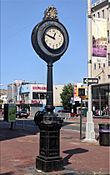Sidewalk clock on Jamaica Avenue facts for kids
|
Sidewalk Clock at 161-10 Jamaica Avenue, New York, NY
|
|

Historic street clock at Jamaica Avenue and Union Hall Street
|
|
| Location | 92-00a Union Hall Street, Jamaica, New York |
|---|---|
| MPS | Sidewalk Clocks of New York City TR |
| NRHP reference No. | 85000931 |
Quick facts for kids Significant dates |
|
| Added to NRHP | April 18, 1985 |
The sidewalk clock on Jamaica Avenue is a very old and special clock. It stands on the corner of Jamaica Avenue and Union Hall Street in Jamaica, Queens, New York City. This clock was built in the early 1900s.
It is made of strong cast iron. The clock has a unique design with a bell-shaped bottom part. It also has a fancy decoration called an anthemion at the very top. This clock was moved in 1989 to its current spot. Today, a Chase Manhattan Bank building stands there. This spot used to be home to a very old stone church. The clock was added to the National Register of Historic Places in 1985. This means it's an important historical landmark.
Contents
The Old Stone Church of Jamaica
The village of Jamaica was first settled by English people. They received permission to build their town, called "Rustdorp," in 1656. About six years later, around 25 families decided to build a church together.
- They voted to build a parsonage, which is a house for the church leader.
- It was 26 feet long and 17 feet wide. This was a very large house for that time.
- Everyone in the town helped pay for it.
This parsonage was used for a few years. Then, the town church was built in the late 1600s. This new church was known by many names. People called it "The Town Church," "The Stone Church," or simply "The Church." It was located on the main street of the village. This was near where Fulton Street and New York Avenue are today.
A Community Hub
For many years, the church was used by everyone. Different church groups used it for worship. It also served as the town hall. Important meetings happened there. It was even used as a court house.
During the 1700s, the "Old Trail" along Jamaica Avenue was very busy. Farmers brought their goods to trade. Horse-drawn carts were common along "Kings Highway." This made the area a lively trading spot.
Church Disputes
Later, a governor named Lord Cornbury took control of the church. He gave it to the Church of England. He said it was paid for by public taxes. The Episcopalians then stopped other groups from using it.
However, the Presbyterian group went to court. They won back both the parsonage and the church. They continued to use it until a new building was built in 1813. Some of the stones from this old church are now in the foundation of the new church on 163rd Street.
The Jamaica Avenue Clock's Story
This famous clock was first put up in 1900. Its original location was at 161-11 Jamaica Avenue. In 1981, it was named a New York City landmark. This means it's a very important part of the city's history.
The clock has two faces, so you can see the time from both sides. It has a strong cast-iron base. The main column is fluted, meaning it has decorative grooves. At the very top, above the clock face, there's a beautiful design called an acroteria motif.
Moving to a New Home
The clock was carefully fixed up and moved in 1989. Its new home is at 92-00a Union Hall Street. A special plaque was placed on the bank building wall. This plaque describes the clock. Another plaque, placed by the Daughters of the American Revolution, tells about the Old Stone Church.
The clock used to stand in front of Busch's Jewellers. It is 15 feet tall, including the decorative top. It looked similar to other cast-iron clocks made between 1881 and 1910. Companies like the E. Howard Clock Company and the Seth Thomas Clock Company made these types of clocks.
How the Clocks Worked
These clocks were sold from catalogs for about $600. That was a lot of money back then! They used a special system with weights to keep time. The weights would slowly fall, making the clock run. They could run for about 8 days before needing to be wound up again.
Most of these clocks had two or four faces. They were usually placed on classic-looking columns and bases. The Jamaica clock's description is unique. It has a "double-faced sidewalk clock with a paneled base, fluted column post on a bell-shaped pedestal with an anthemion Finial motif above the clock-face." This description suggests it might be from a different maker. One idea is that it came from the Hecla Iron Works in Williamsburg.
Past and Present Details
At one point, the words 'Tad's Steaks' were added to the clock in neon lights. These were later removed when the clock was restored. The anthemion finial is a decorative design. It was used in ancient Greek and Roman buildings. The word "anthemion" means honeysuckle. Its parts often curl inward, like the plant.








